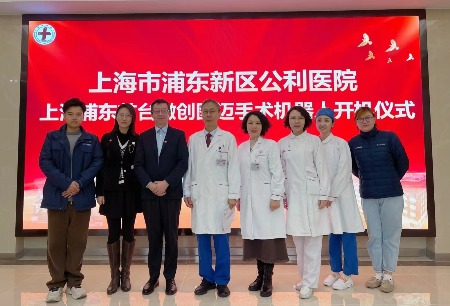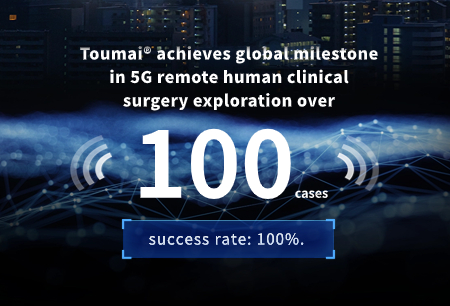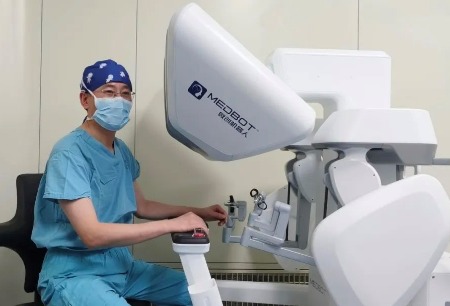On November 3, 2022 - The first spleen-preserving distal pancreatectomy (Warshaw operation) assisted with Toumai® in China was successfully completed by the team of the Hepatobiliary Surgery Department of the Second Hospital of Shandong University, which removed the tumor and preserved important organs for the patient. This is another important breakthrough made by the Hepatobiliary Surgery Department of the Second Hospital of Shandong University after they completed the first resection of pancreatic tumor assisted with Toumai® in Shandong Province on October 10. The successful completion of these two challenging hepatobiliary surgeries in a row has once again verified the clinical performance of Toumai® in complex surgeries. With stable, safe and efficient product performance, the Toumai® Laparoscopic Surgical Robot provides a strong technological guarantee to assist surgeons and benefit patients.
The spleen-preserving resection of the tail tumor of the pancreatic body was performed by Prof. Bin Jin, Vice President and Head Surgeon of the Second Hospital Shandong University, with the assistance of the Toumai® . The patient, a middle-aged female, was admitted to the hospital because physical examination revealed a tumor in the pancreas tail. Preoperative imaging showed a tumor of nearly 6 cm in diameter in the caudal part of her pancreatic tail. Due to the close connection between the tumor and the splenic vessels, there was a possibility that the spleen immediately caudal to the pancreas could not be preserved, which would subsequently seriously affect the postoperative quality of life. In addition, the anatomy of the pancreas was complex, the tail of the pancreas was close to the splenic portal, adjacent to important large blood vessels and rich in peripheral vessels, and the blood supply to the spleen must be preserved during surgery, which required high surgical techniques and made the operation difficult, bringing great preoperative pressure to both patients and surgeons.
In order to preserve the spleen and improve the post-operative life quality of the patient, the team led by Prof. Bin Jin discussed the surgery scheme carefully, had thorough communication with the patient and her family members, and finally decided to perform the spleen-preserving distal pancreatectomy assisted by Toumai®. The surgical facts prove that the Toumai® has become the right assistant for the operator to complete the surgery safely with its clear 3D vision, flexible instruments , hand shaking filtering and other outstanding performance.
The spleen-preserving surgery is highly difficult, and presents high requirements on clinical skills, team coordination and the stability of the surgrey system. Generally, there are two methods to perform the spleen-preserving distal pancreatectomy. The first one is called the Kimura method that completely preserve the arteries and veins of the spleen. The second one is called the Warshaw method. In the Warshaw method, the trunk sections of the arteries and veins of the spleen will not be preserved, and only the collateral circulatory system dominated by the short gastric veins and the left gastroepiploic veins are preserved to maintain the blood supply to the spleen and its back flow.
The tumor was found to be severely adhered to the blood vessels of the spleen, so Prof. Bin Jin used the Warshaw method to remove the tumor. With the high dexterity of the Toumai® four-arm surgical robot, the tumor was peeled and dissected efficiently, and the adhered parts were treated with great delicacy like "peeling off a cocoon". Only about 30ml of blood was lost during the process and no transfusion was performed. The intraoperative rapid cryopathology results suggested a benign tumor.
Finally, with the close cooperation of the Second Department of Anesthesia and the Second Department of Surgery, Prof. Bin Jin and other two members Xiaoming Li and Wendong Liu, successfully removed the tumor and preserved the spleen within two hours. Postoperatively, good blood supply to the spleen was observed, and the patient recovered extremely quickly and was able to out ofbed activities in one day after surgery.
This is another highly challenging surgery completed by Toumai®. The sophisticated skills of the surgeon in combination the fine, safe and stable assistance of Toumai® have enabled a safer and more minimally invasive surgery experience and quicker post-operative recovery for the patient.
Previously, Prof. Bin Jin and his team successfully completed a resection of pancreatic tumor assisted with Toumai® on October 10. Postoperatively, the patient recovered well and was able to out of bed activities within the same day. This surgery represents another breakthrough of The Second Hospital of Shandong University after its successful completion of the first liver and biliary tract surgery assisted with Toumai® in Shandong province. Meanwhile, this surgery is the first resection of pancreatic tumor assisted with a Chinese-developed surgical robot in Shandong province.
The surgical patient was a middle-aged woman who came to the Second Hospital of Shandong University seeking treatment for a cystic tumor found in the tail of the pancreatic body, which was initially judged to be a benign tumor of the pancreas. As the tumor was large and closely connected with some important blood vessels around it, the surgery was very difficult. Prof. Bin Jin said: “The challenge is to preserve the good tissues as much as possible and avoid any damage to the blood vessels while removing the tumor. You got to be very careful in order not to cause damages to the organs around, especially when you are dealing with the arteries and veins of the spleen.”
During the surgery, Prof. Bin Jin operated the system skillfully at the console, and accurately control the movement of the mechanical wrist in synchronous coordination with the eyes, hands and the robotic arm. With the high-resolution 3D vision, peeling and anastomosis were completed in a narrow space, the tumor was successfully removed, and the important blood vessels and organs around were completely preserved. The minimally invasive surgery was completed with high level of precision, and the amount of bleeding was less than 10 ml. All of these significantly reduced the risk of infection and complication, and helped improve the post-operative life quality of the patient.
Following the breakthroughs made in the urology surgery department, the endocrinology department, the gynecology department and the general surgery department, the completion of these two challenging and risky pancreatic tumor surgeries indicates another milestone achieved by Toumai®, and also a step forward into the field of the hepatological surgery. This is not only significant for The Second Hospital of Shandong University, which means the hospital's ability to use the robot for clinical surgery is more mature, but also demonstrates the stable and excellent performance of Toumai® in assisting surgeons to perform difficult surgeries. After many successful cases of clinical applications, Toumai® has won the recognition and trust of more and more hospitals and head surgeons.
Prof. Bin Jin pointed out the robot assisted surgery system has remedied the defect of the conventional laparoscopic surgery, made the surgery more minimally invasive and finer, and brought revolutionary changes to the surgeries. The Toumai® Laparoscopic Surgical Robot used in this surgery demonstrated its stable, accurate and safe technology advantages. It preserves more physiological functions for the patient through more minimally invasive surgical operation. In respect of operation experience, it is very friendly to the surgeon with a short learning curve and significantly reduced the fatigue of the surgeon during the surgery. It is hoped that the Chinese-developed surgical robots will surpass the oversea high-end medical devices through continuous improvement, and provide even greater help with the clinical surgery.
Mr. Yu Liu, Executive Vice President and Chief Commercial Officer of MicroPort® MedBot®, said that the successful completion of this difficult spleen-preserving pancreatic tail tumor resection was a result of Prof. Bin Jin's excellent surgical skills and another proof of the growing clinical application capabilities of the Toumai®. MedBot® will continue to strengthen the communication with the surgeons, and identify the direction of optimization and improvement based on their feedbacks, thus further improving the operation experience of the surgeon and the performance of the robot. In this way, we hope to enable the Chinese-developed surgical robot to address more challenging surgeries, bring more benefits to the patients, and realize the original aspiration of “Make Surgery Easier, Safer and Less Invasive”.
-
 2023-01-12Xinmin Evening News, Wenhui Daily, and Pudong Release Focus: Acceleration of Commercialization Process for Chinese-developed Laparoscopic Surgical Robots, Toumai® Deployed at Gongli Hospital
2023-01-12Xinmin Evening News, Wenhui Daily, and Pudong Release Focus: Acceleration of Commercialization Process for Chinese-developed Laparoscopic Surgical Robots, Toumai® Deployed at Gongli Hospital -
 2023-01-09Toumai®'s completion of 100 cases of 5G tele-surgery marks a milestone in the global development of tele-surgery
2023-01-09Toumai®'s completion of 100 cases of 5G tele-surgery marks a milestone in the global development of tele-surgery -
 2022-12-26Toumai® promotes minimally invasive surgery's progress in multi-departments, aiding the advancement of quality healthcare in Jingzhou
2022-12-26Toumai® promotes minimally invasive surgery's progress in multi-departments, aiding the advancement of quality healthcare in Jingzhou




 " are registered trademarks of Shanghai MicroPort Medical (Group) Co., Ltd.” . They have been authorized to be used by Shanghai Microport Medbot (Group) Co., Ltd., and no other party shall use such trademarks without prior written permission thereof.
" are registered trademarks of Shanghai MicroPort Medical (Group) Co., Ltd.” . They have been authorized to be used by Shanghai Microport Medbot (Group) Co., Ltd., and no other party shall use such trademarks without prior written permission thereof.
